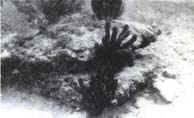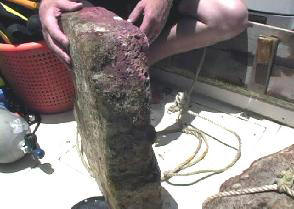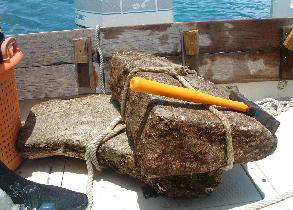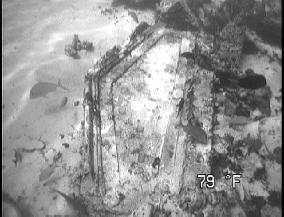
Eugene (Gene) Shinn, of the US Geological Survey, published a 1978 article regarding Bimini Road in the obscure journal Sea Frontiers. All of his later articles were based on his 1978 findings and, sadly, modern geology textbooks and other articles have, for decades, reported information based on the subsequent alterations. Peer review of the later articles has long been necessary.
In that original 1978 article Shinn reported on the results of 17 cores taken from stones at the Bimini Road: "Eight separate adjoining blocks in the northern area and nine blocks plus one bedrock core in the southern area were cored." (p. 138) In his results, Shinn wrote: "At the northern site...beach bedding was not readily visible in these cores... (p. 139). "At the southern site...Bedding in all the cores from this area was either horizontal or dipping predominantly toward the sea." (p. 138)
In contrast, in his second article on Bimini, coauthored with Marshall McKusick in Nature in 1980, Shinn summarized his results as follows: "A sample of 17 oriented cores ... has been examined with X-radiographs. Two areas in the formation were studied, and both show slope and uniform particle size, bedding planes, and constant dip direction from one block to the next." This statement is inconsistent with what Shinn originally reported in 1978; that they did not show uniform slope and constant dip from one stone to another. Coauthor Marshall McKusick has never visited Bimini.
In his third article on Bimini, published in 2004 in the Skeptical Inquirer, Shinn simply summarized the results from his 17 cores as follows: "all the cores showed consistent dipping of strata toward the deep water..." This statement is also inconsistent with the report from which it is derived.
The essence of what Shinn actually found is simple. Of his 17 cores, 8 in one area had no bedding plane or measurable dipping whatsoever. In the other area of 9 cores, he reported no actual numbers only that they either were horizontal or dipping.
FEWER THAN 25% were dipping toward the sea.
Gene Shin has also reported that all of the stones that comprise the Bimini formation are laying on sand or bedrock - that is, only one layer of stones is present there. He states: "Coring and examination showed they rest directly on weathered Pleistocene limestone." Numerous photos by others have shown otherwise.

An early 1978 photo by English professor Dr. David Zink shows a Bimini Road block sitting squarely atop another block.
Since the above photo was taken numerous huge slabs placed squarely into multiple tiers have been sited and photographed. Gene Shin's photos show only the tops of stones covered by sand.
Eugene Shinn's Sea Frontiers article, sans the photographs in it, can be viewed in a pdf file by clicking below. This file is presented below for research purposes.
The relevant portions of the Nature article by McKusick and Shinn can be viewed in a pdf file by clicking below. The excerpts are also presented for research purposes.
There are other components of the skeptics� assertions that the Bimini Road formation is natural limestone (beachrock) that fractured in place. These are:
1. That no prop, or leveling, stones or blocks are present under any of the slabs. Findings in 2005 and 2006 proved otherwise.

Support stone removed from beneath a large block of the Bimini Road.
Under the scrutiny of an NBC News film crew Psychologist-turned-explorer Dr. Greg Little removed several such stones and later brought them to the surface for examination.

A wedge stone removed from under a large block of the Bimini Road.
2. That no human ancient artefacts, or toolmarks, are present on the site. In fact Archeologist Bill Donato discovered that there are a number of mortise, and tenon, stones found at the site and many stones display toolmarks. Dr. Little, and his wife Dr. Lora Little, have also discovered dozens of stone anchors there, with unmistakable rope grooves on them or holes drilled through them.
3. That all the Bimini Road stones were beachrock, a naturally developing coarse limestone. A number of researchers have determined this not to be the case. Many of the stones are not beachrock. Moreover beachrock was the most common construction material used in ancient Mediterranean harbors.
In fact the evidence shows that the Bimini Road is actually the remains of an ancient harbour with the stone formation serving as a breakwater and quay. Since then Dr. Little has found many other ruins near Bimini.

In 2007, in an area about 7-miles north of Bimini, under sand and debris, are found some interesting stone blocks including the above triangular, well-polished stone slab which appears to be the apex of a roof on a temple. It's about 7-feet long and, embedded in sand, its thickness is at least three feet thick. Several small pieces from the edge of this apex were removed and brought to the surface. It's white marble that gleams like quartz in the sun.
Conclusion: The Bimini Road site presents evidence of an ancient maritime culture and further study of it, and other proximal sites, is merited.

Archaeological Ruins Near Bimini
Related Articles by Dr. Greg Little